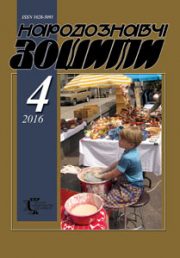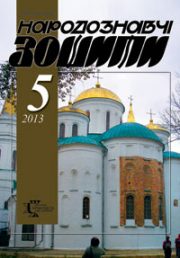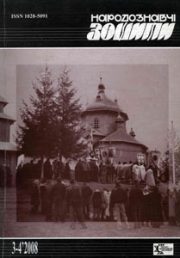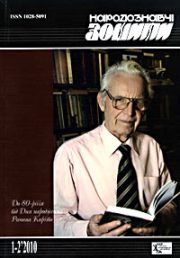The Ethnology Notebooks. 2023. № 3 (171), 777—791
UDK [930.2:746.3-037:39](477+474.5):140.8
DOI https://doi.org/10.15407/nz2023.03.777
TOWEL FUNCTIONS: COMPARATIVE ANALYSIS OF UKRAINIAN AND LITHUANIAN TRADITIONS
HERUS Lyudmyla
- ORCID ID: https://orcid.org/0000-0002-5931-3816
- Doctor of Sciences in History,
- Сandidate of Аrt Studying (Ph.D.), Head of Department,
- The Institute of Ethnology of the National Academy
- of Sciences of Ukraine,
- Department of Folk Art,
- 15, Svoboda Avenue, 79000, Lviv, Ukraine,
- Contacts: e-mail: ludmilagerus@gmail.com
KUMPIKAITĖ Eglė
- ORCID ID: https://orcid.org/0000-0002-4786-8144
- Ph.D. in Technical Sciences, associate professor,
- Kaunas University of Technology,
- Faculty of Mechanical Engineering and Design,
- Department of Production Engineering,
- 56 Studentu str., LT-51424, Kaunas, Lithuania,
- Contacts: e-mail: egle.kumpikaite@ktu.lt
NENARTAVIČIŪTĖ Erika
- senior officer Open Air Museum of Lithuania in Rumљiљkės,
- Department of Everyday Life, Folk Trades and Crafts,
- 2 L.Lekaviиiaus str., LT-56337 Rumљiљkės, Kaiљiadoris district, Lithuania,
- Contacts: mail: erikanort@yahoo.com
Abstract. The article was written based on the results of the Ukrainian-Lithuanian interdisciplinary R&D projects «Ornamentation of Western Ukrainian and Lithuanian Folk Textile: Universal and Unique Parameters» (2018—2019) and «Unique Technologies of Ethnographic Textile: Experience of Preservation in Western Ukraine and Lithuania» (2022—2023) (the project have been supported by the Lithuanian Research Council and the Ministry of Education and Science of Ukraine [grant number in Lithuania S-LU-22-5]).
The woven and embroidered towel retains its significance in the modern socio-cultural space of Ukraine and Lithuania. Constant attention and study of the traditional towel phenomenon will contribute to the growth of opportunities and expediency of using historical experience and knowledge, and their broader interpretation for preservation, continuation and development.
The article’s purpose is to highlight the philosophical foundations of the towel material existence as an artefact in the traditional culture of Ukrainians and Lithuanians, to reveal similarities and differences in its functioning, and to show the interdependence of the towel function and its external visual parameters.
The object of the study is the traditional culture of Ukrainians and Lithuanians, and the subject is the towel function in the everyday life and rituals of both peoples.
The source base consists of the results of the author’s field research of the habitats of the traditional towel (oral information and photo-fixation), as well as the study of the museums` expositions of Ukraine and Lithuania (scientific description and photo-fixation).
The comparative analysis method was used to study the features of Ukrainian and Lithuanian towels functioning. The worldview context of the towel perception in traditional culture was clarified by the phenomenological analysis method.
Conclusion. Analysis of the towels functioning in Ukrainian and Lithuanian culture demonstrates a wide range of options: ceremonial — birth, wedding, funeral, occasional; interior — on an icon, on a peg, on a shelf, etc.; household — for kitchen utensils and dishes, for the body, for carrying burdens.
Many analogies can be traced in the towel functioning of Ukrainians and Lithuanians, which is obviously determined by both the worldviews that formed the ritual context and the living environment, in particular, the advantages of agriculture and cattle breeding in the management of the economy. The artefacts’ visual parameters — the shape with its own size, structure and decor depended on the available raw materials and technological capabilities and are a figurative material expression of worldview meanings transmitted from generation to generation by means of tradition — are also a confirmation of the similarity. It is a peculiar Lithuanian tradition to hang a towel in the house on the wall on a decorated wooden shelf. Ukrainians usually hung interior towels on icons, paintings, portraits, on pegs driven into the wall, poles placed between the walls, etc.
Keywords: ritual, towel, function, artefact, culture, Lithuania, Ukraine.
Received 3.06.2023
REFERENCES
- Nykorak, O. (2004). The Ukrainian Traditional Folk Cloths of XIX and XX cc. Interior Cloths (Based on Materials from Ukrainian Western Regions) (Part I). Lviv: Ethnology Institute of NAS of Ukraine [in Ukrainian].
- Boriak, О. (1997). Weaving in the Rituals and Beliefs of Ukrainians (middle XIX — Early XX Centuries). Kyiv [in Ukrainian].
- Zakharchuk-Chuhai, R.V. (1999). Folk Decorative Art. In Ukrainian Polissia. Historical and Ethnographic Research. Ovruchchyna. 1995 (Issue 2, pp. 302—304). Lviv: NAS of Ukraine; Ethnology Institute [in Ukrainian].
- Lupii, T. (2000). Ritual Towel and Mythological Picture of the World. Folk Art and Ethnology, 5—6, 104—109 [in Ukrainian].
- Lupii, T. (2000). Semantics of the Towel in Wedding, Funeral and Commemorations Rituals. Berehynia, 3, 5—16 [in Ukrainian].
- Kitova, S. (2003). Cloth Chronicle of Ukraine: Semantics of Ukrainian Towel Ornament. Cherkasy: Brama [in Ukrainian].
- Kara-Vasilyeva, T. (2008). History of Ukrainian embroidery: book-album. Kyiv: Art [in Ukrainian].
- Andrushko, L. (2010). Ukrainian Towel as Polyfunctional Sacral Work of Folk Art: Function, Typology, Semantics, Artistic Features. Lviv [in Ukrainian].
- Balcikonis, J. et al. (1962). Lithuanian Folk Art. Woven Fabrics II Book. Vilnius: Valstybine grozines literaturos leidykla [in Lithuanian].
- Bernotaite-Beliauskiene, D. (2018). For body and soul: towels. Part II. Folk culture, 6, 66—74 [in Lithuanian].
- Kumpikaite, E, Kot, L, & Tautkute-Stankuviene, I. (2016). Ornamentation of Lithuanian Ethnographic Home Textiles. FIBRES & TEXTILES in Eastern Europe, 5 (119), 100—109.
- Kumpikaite, E., Kot, L., & Nenartaviciute, E. (2014). Comparable Analysis of Folk Home Textile of East Prussia in Territories of Lithuania and Poland. Open Journal of Social Sciences, 10, 19—29.
- Borysenko, V.K. (1988). Wedding customs and rites in Ukraine. Historical and ethnographic research. Kyiv: Naukova dumka [in Ukrainian].
- Vovk, Khv. (1995.). Marriage ritual and rites in Ukraine. Studies in Ukrainian ethnography and anthrop.ology (Pр. 219—323) Kyiv [in Ukrainian].
- Borysenko, V.K. (1994). Wedding customs and rites. Podillia: Historical and ethnographic research (Pр. 217—228). Kyiv [in Ukrainian].
- Bulgakova, L. (1999). Polish towel of the 20th century. In Ukrainian Polissia. Historical and Ethnographic Research. Ovruchchyna. 1995 (Issue 2, pp. 329—340). Lviv: NAS of Ukraine; Ethnology Institute [in Ukrainian].
- Herus, L. (2018). Bread and Cloth in Ukrainian Rituality: Functions and Semantics. The Ethnology Notebooks, 5 (143), 1096—1105 [in Ukrainian].
- Nykorak, О., Herus, L., & Kutsyr, T. (2022). Рatterned Woven Sashes of Western Ukraine and Lithuania: Techniques, Ornamentation, Functions. The Ethnology Notebooks, 5 (167), 1147—1163 [in Ukrainian].
- Boryak, O. (1996). Production of woven ritual symbols in Polissia. Polissia: Language, culture, history: Proceedings of the International Conference (Рр. 288—295). Kyiv [in Ukrainian].
- Halaichuk, V. (2003). «Relationships» between a person and a household in the beliefs of the Ukrainians of Polissia. Bulletin of Lviv University. The series is historical (Issue 38, pp. 568—584). Lviv [in Ukrainian].
- Kutelmakh, K.M. (1999). Agrarian motifs in the calendar rituals of Polish pike. In Ukrainian Polissia. Historical and Ethnographic Research. Ovruchchyna. 1995 (Issue 2, pp. 191—210). Lviv: NAS of Ukraine; Ethnology Institute [in Ukrainian].
- Hrebin, I.F. (1994). Rites related to the construction of rural housing. Podillia: Historical and ethnographic research (Рр. 243—250). Kyiv: Naukova dumka [in Ukrainian].
- Siletskyi, R. (1997). «Zakladshchyna» hut in Polissia: Ritual and customary aspect. In Ukrainian Polissia. Historical and Ethnographic Research. Kyiv Polissia. 1994 (Issue 1, pp. 83—96). Lviv: NAS of Ukraine; Ethnology Institute [in Ukrainian].
- Siletsky, R.B. (2003). Customs and rites related to construction. Polissia of Ukraine. In Ukrainian Polissia. Historical and Ethnographic Research. In the confluence of the Uzha and Tetereva rivers. 1996 (Issue 3, pp. 95—124). Lviv: NAS of Ukraine; Ethnology Institute [in Ukrainian].
- Herus, L.M. (2009). Ceremonial bread «karachun» (interrelationship of symbolism and plastic interpretation of form). Lemkowie, Bojkowie, Rusini — history, wspolczesnosc, material and spiritual culture (Issue 2, pp. 145—150). Zielona Gora; Slupsk: Drukar.







